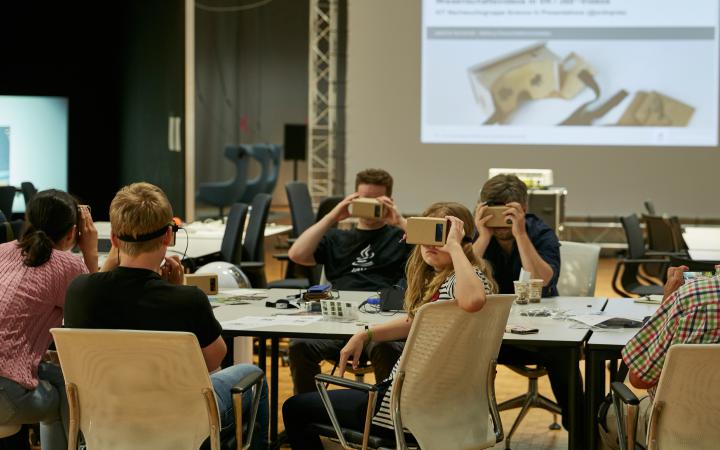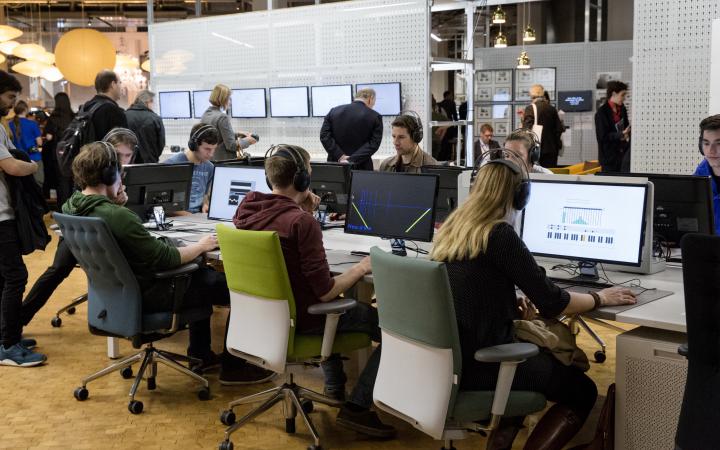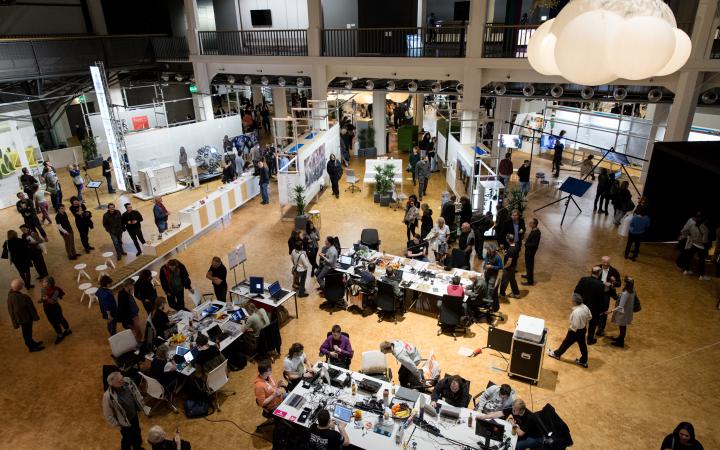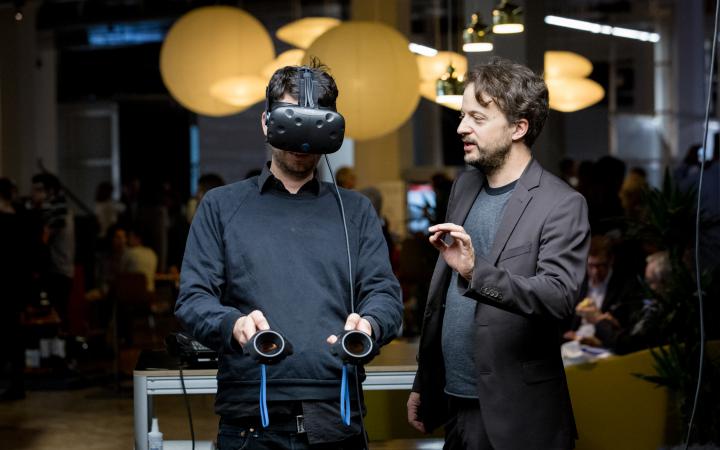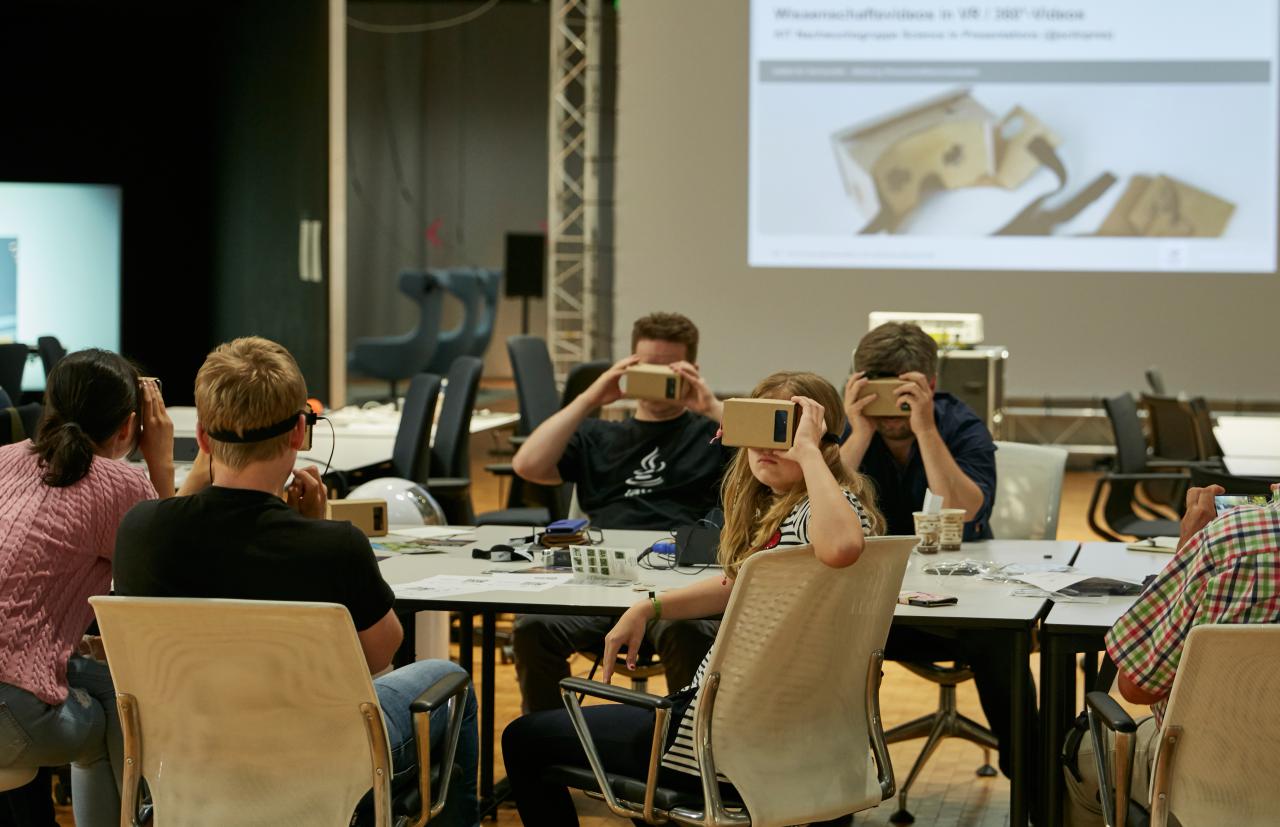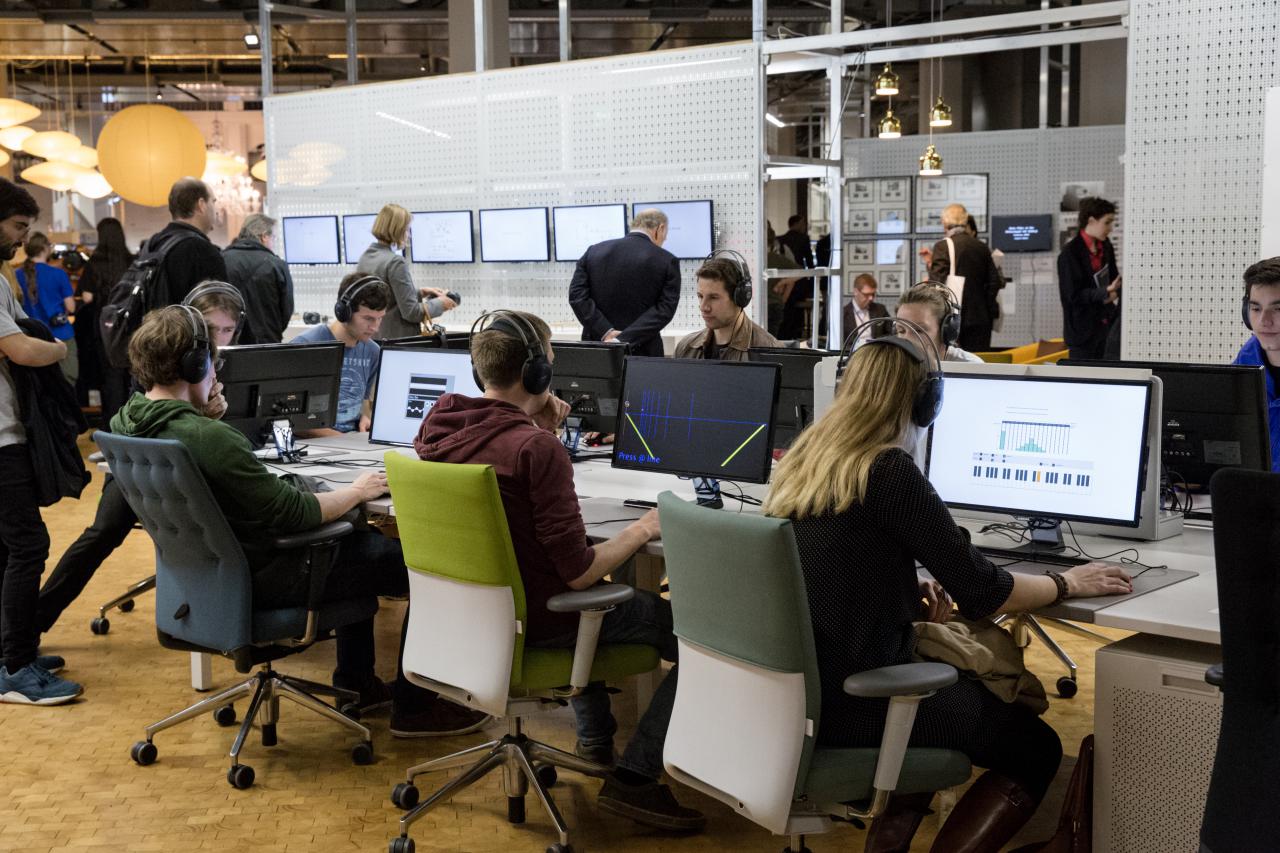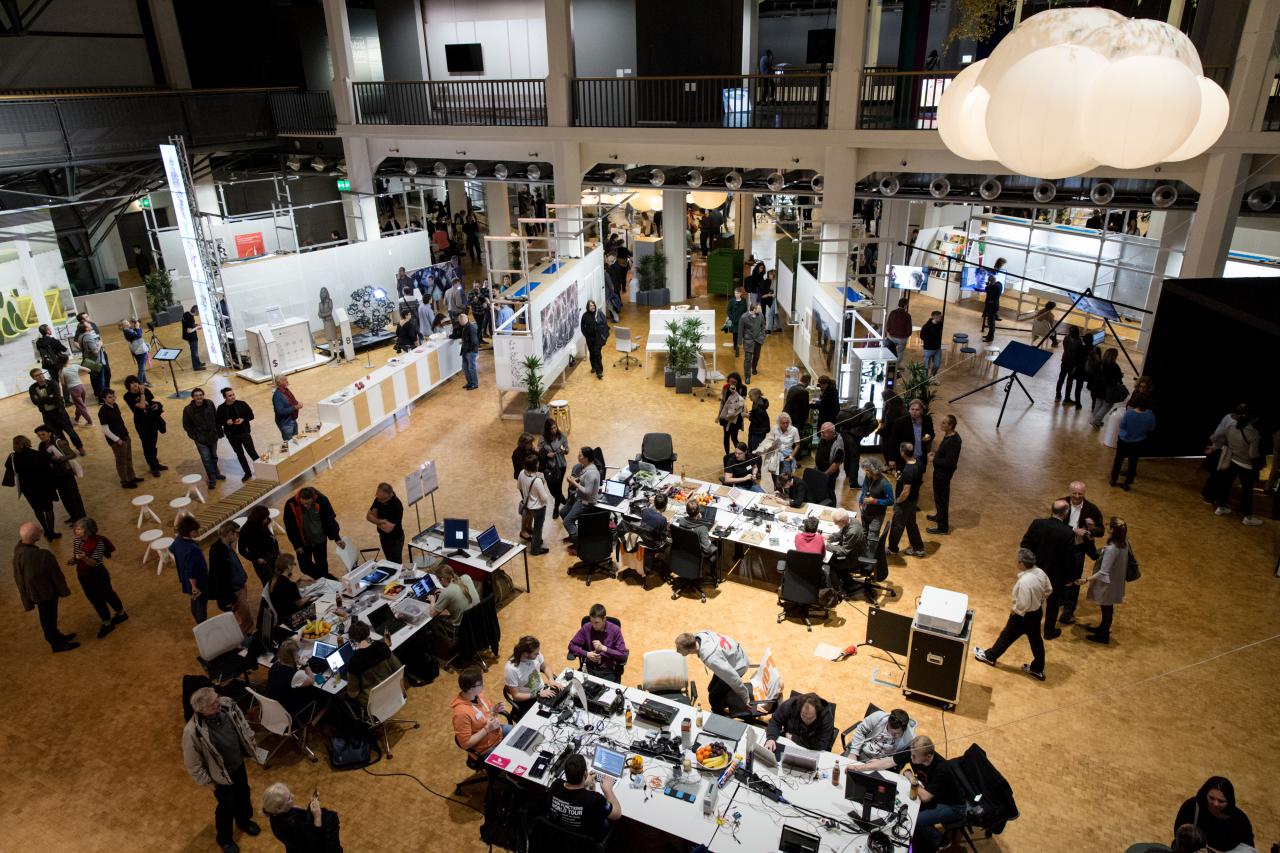Editorial
The World as a Field of Data
The remarkable education experiment continues!
Free admission, free fruit, free drinks, and free flow of ideas
Phase I of Open Codes presented many varied examples of codes, from Morse code to the genetic code, as well as their applications in art and industry. In Phase II of Open Codes, the focus is on exploring a world that is not solely generated, driven, and controlled by things, words, and images, but above all by data. Living in digital worlds means increasingly a life spent in a programmed, smart environment, a so-called »scripted reality.« The script is dictated in part by sensors, which provide information about the state of reality around us. The data from the sensors is processed by algorithms, which steer us through the world as though through a field of data. For the world we live in is more and more an artificial, human-made data world. That is why you are confronted by around 40 monitors in ZKM’s Atrium 8, which hang over the atrium as a data cloud. In an exaggerated way they show us the vast number of electronic interfaces, like smartphones, computers, TVs, and data displays, which accompany us 24/7 in airports or railway stations, at the stock exchange and in banks, in offices and at home, in hospitals and doctors’ surgeries. Open Codes II provides an insight into the post-text data world; a world in which text forms are now history and are being increasingly replaced by numerical codes.
Fields of Data
In the world as a field of data the old means of navigating, for example, by sun, moon, and stars, no longer have the same significance. What Immanuel Kant wrote in the Critique of Practical Reason (1788), »Two things fill the mind with ever new and increasing admiration and awe, the oftener and the more steadily we reflect on them: the starry heavens above and the moral law within,« [1] is only of limited validity today. Without doubt some people may still carry moral law within them, but they are not gazing at the firmament, the starry heavens, but looking at the display in front of them. It is not just two things that fill the mind today. Where does that leave awe and moral law? Nobody sees heaven and morality before them; but rather behind them. In the age of post-theism ever new and increasing admiration is reserved for the screens and displays in front of one. It is the displays and data which connect modern people directly with the consciousness of their existence. It is they that point the way for people; they have replaced the old means of navigating, the sun, the moon, and the stars. People in the digital age take their bearings from the nearest cell tower, from orbiting satellites, and are directed to their destination by algorithms. Today, people travel without a passport, but with a mobile phone. If you ask the under 50s where they frequently look – at the sky, at people’s faces, or at the display of their mobile – one can easily come to the conclusion that most of them look at their phone, a few look at people’s faces, and practically nobody looks at the sky. Another observation shows the changed world as a field of data. If you get stuck in a traffic jam with your car, you have two options: you can send a fervent prayer to God in his heaven, or you can put your trust in the information supplied by your satellite navigation system, which processes the traffic situation in code with the aid of satellites in space. You either trust the voice of God or the automated navigation voice on your satnav. Early forms of artificial intelligence have made it possible for your satnav device to speak to you as only humans could before.
Philosophers, René Descartes (1596–1650) for example, had once assumed that on the one hand the res extensa, the world of objects, exists, and on the other, the res cogitans, the world of thinking subjects, who alone possess the faculty of speech. Language sets humans apart from the animals and the world of objects. This is the thinking behind the title of a book by the famous philosopher Charles Taylor, who lives in Canada, published in 2016: The Language Animal. This book title contains two errors and requires two corrections. First, it should read »the predatory animal with a gift for languages.« Second, we know since the advent of Siri und Alexa that the animal with a gift for languages named Homo sapiens (res cogitans) has also taught objects (res extensa) to speak. In the world as a field of data, in the digital world, in the world of digital codes and media, it is not only humans that speak, but also »things.« And more and more «things« will speak to us. Artifacts like bots will probably provide information more competently, politely, helpfully, and multilingually than humans in the future.
The second edition of Open Codes will show you this new world of fields of data in an abundance of examples. It opens to us a new horizon for humankind: transhumanism built on artificial intelligence.
Machine Code = Statement and Execution
The basis of our data world, as everybody knows, is the binary code, the world made of 0s and 1s. While the alphabetical code predominated as the primary code for human culture and communication for thousands of years, today numerical code dominates our world. This code essentially consists of the ten numerals 1 to 9 and 0, through which an almost infinite number of numbers can be formed. What Samuel Morse did in 1833 for the alphabetical code, namely, reduce the 26 letters of the Latin alphabet to long and short signals, Gottfried Wilhelm Leibniz accomplished in 1697 for the numeric code.[2] Leibniz proved that all numbers can be represented by just two digits, 0 and 1. He did not take words, images or numbers as counterparts for objects as was usual, but rather allocated digits to numbers for the first time: “Numbers can be used to express all kinds of true sentences and deductions” (Leibniz, De progressione dyadica, 1679). Leibniz’s binary number system, his binary code, with which he began to translate words and sentences into numbers, was a prerequisite for the digital code of today.
As all information in the digital world is processed as numbers, letters of the alphabet and numerals are depicted as bit sequences in the computer. The combinations of 0 and 1 (bits) can be stated as numbers, signs, or letters (e.g., a = 1100 0001; b = 1100 0010). In coding theory, the elements that make up the code are called “code words,” and the symbols that make up the code words are called the “alphabet.” Whereas until recently, the code systems of language and writing served the purposes of communication between people, today many code systems are available which also enable people to communicate with machines and things. These include the bar codes and QR codes of merchandise management, as well as the important ASCII (American Standard Code for Information Interchange), which is used for coding character sets.
In computer science, the text of a computer program which is written in a programming language in a way that is legible to people is called source code, source text, or program code. It is created according to the rules of the respective programming language. Source code is often written in ASCII code. In order for the computer to execute the source code, it has to be converted into machine language, that is, into commands that can be executed by a processor. This leads to a significant difference between the historic forms of code and today’s binary forms of code. Linguistic codes, pictorial codes, also numeric codes, in short: human codes, are only instructions. Take, for example, music notation, which has been standard for about a thousand years, since Guido von Arezzo (c. 992– c. 1050). Music notation is a code that first has to be learned, yet it is still only instructions for people that tell them how to apply the code to the instruments in question. Learning this code is a process that takes years of continual practice. Thus classic codes are instructions and require humans to execute them. Machine codes, by contrast, are instruction and execution in one. If you press numbers and operator buttons on a calculator, like +, –, = , the machine does the computing and the result appears on the display, the data field, without you having to do anything further. The new, fundamental noetic turn thus consists in machine codes being at once instruction and execution. Thus, after the historic insults to humanity associated with the names Nicolaus Copernicus, Charles Darwin, and Sigmund Freud (the Earth is not located at the center of the universe; humans are the product of evolution and are descended from apes, not God; they are not even in control in their own home (the self) because they are driven by the subconscious), a further insult awaits in the world as a field of data: Humans lack the knowledge and skills to solve the problems they have created, and are obliged to rely on algorithms, artificial intelligence, and machine codes to support their attempts to arrive at solutions and decisions. Humans will have to get used to the idea that in the future not only animals are our fellow beings, but also plants, objects, and machines will rise to become coequal, if not superior, fellow beings.
On the History of Digitization
Important twentieth-century philosophical books bear titles such as Word and Object (Willard Van Orman Quine, 1960) and Les Mots et les choses (Michel Foucault, 1966)[3]. These books tell of an analogue world that consists primarily of things and of the relationship between things and words. Thus in these texts, language is the instrument that orders the world. Hence Ludwig Wittgenstein’s famous dictum says, »The limits of my language mean the limits of my world.«[4]
Indeed, language was the first tool which enabled people to explain and shape the world. People gave names to things, and these relations between words and things were decisive for culture and civilization for thousands of years. Just as people gave names to things, they also assigned pictures to things, which gave rise to a second cultural technology; the art of imagery, from painting to photography. The things also generated sounds; moreover, people even created new things especially to produce sounds.
The world of images, words, and sounds was soon joined by the world of numbers. Mathematics is the world of numbers. The evolution of digitization proceeded in three stages. The first stage of digitization, or rather the mathematization of the world, began with the mathematization of physics. In 1623, Galileo Galilei wrote, »Nature is a book written in the language of mathematics.« [5] Depicting things in words and images in itself represents a considerable level of human abstraction. Expressing the world in numbers which took on a life of its own as mathematics, was the as yet highest stage of a cultural technology that distinguished people from all other living creatures. This increased abstraction through mathematics and the development of the natural sciences as mathematical disciplines digitization began in the proper sense 400 years ago. Mathematics became a universal language.
To put it simply and schematically: in the seventeenth and eighteenth centuries the mathematization of physics took place (1st stage), and in the nineteenth and first half of the twentieth century the mathematization of thought (2nd stage). In the latter half of the twentieth century both tendencies converged in the development of electronics (3rd stage). In his monumental Philosophiae Naturalis Principia Mathematica of 1686, Isaac Newton laid the foundations for describing nature in mathematical terms. Joseph-Louis de Lagrange’s 1788 masterpiece Méchanique analytique was the first work to offer a full description of the universe on the basis of pure algebraic operations. He carried physics over into analytical mathematics. Lagrange algebraized mathematics and mathematized physics. This algebraization of physics led to the second stage of digitization: the algebraization of logic (of formal thought). Logical forms were captured with the aid of mathematical methods and terms. As a response to Newton’s Principia, Bertrand Russell and Alfred North Whitehead published their three-volume work Principia Mathematica, 1910–1913. Like Gottlob Frege, who used his 1879 work Begriffsschrift. Eine der arithmetischen nachgebildete Formelsprache des reinen Denkens to translate thought into mathematical formulas, Russell and Whitehead portrayed thinking and logic in mathematical terms.
A milestone was set by George Boole who defined the laws of thinking as laws of formal logic and these in turn, building on Lagrange, as algebraic mathematics. In The Mathematical Analysis of Logic (1847) and An Investigation of the Laws of Thought (1854), Boole proved that logic and algebra are identical by expressing logical statements as algebraic equations. Alan Turing, ultimately, brought these tendencies to mathematize the world, language, and thought to their culmination in his famous 1936 essay “On Computable Numbers.” Turing’s depiction of the calculability of numbers and number processes is considered the foundational paper for the development of the digital computer, for what is known as the Turing machine. Henceforth one no longer just calculated with numbers but rather numbers became calculable. With calculable numbers, nature becomes computable.
With the further development of the computer from a pure calculating machine to a machine of images, sound, and language, a new world of data emerged. Images and texts can be computed and visual and acoustic worlds can be simulated. In a word, everything that was previously made up of objects, words, sounds, and images can be represented in numbers and constructed from numbers. The crucial aspect of this digital cultural technology is a hitherto unimaginable reversibility. In the analogue world the principle of irreversibility prevails in the relationship between things and words or images. Things can be transformed into words, but not words can be retransformed into things, because the word “chair” is not actually a chair. Things can be transformed into images, but not images into thing, because the picture of a pipe is not a pipe, to cite René Magritte’s 1929 painting La trahison des images, which displays the image of a pipe and below it the words Ceci n’est pas une pipe – this is not a pipe. In the era of digitization, words, images and sounds are transformed into data, and – for the first time in human history – this data can be transformed back into sounds, images, and words. And with 3-D printing data can even be transformed into things. The relation between data and things, words, images are reversible. The language of data, algorithms, and programming languages has become a universal language out of which the world of sounds, images, texts, and things emerges. Thus mathematics has long since ceased to be just the language of nature; it has become the language of culture. The book that describes the contemporary world must be titled The Things and the Data. The relationship between things, words, and images used to be irreversible. However, now the relationships between data and words, images and sounds are reversible in the digital world.
Digital Codes
Digital cultural technology, however, has also provided the foundations for another revolution, which will possibly usher in a new era. Culture to date has been based on two-dimensional notation: notes, numbers, and signs on paper are notated and fixed just like writing. The computer, however, enables the simulation of moving three-dimensional spaces, and in this way enables a future, three-dimensional notation which is already being used today by architects and designers. 3-D cinema was the first attempt along these lines, but it is with 3-D printing that this future begins to become a reality through the aforementioned possibilities of reversible transformations. Thanks to the development of this cultural technology, which renders the relationship between the worlds of things and signs reversible, we will live in an environment that is underpinned by sensors and intelligent agents, managed by codes and algorithms, and equipped with artificial intelligence.
The fact that this has become possible goes back to »The Unreasonable Effectiveness of Mathematics in the Natural Sciences,« which was ascertained by Nobel Laureate Eugene Wigner in 1960. Reality is what can be expressed mathematically and electronically controlled. The best example of this is Claude E. Shannon’s 1937 master’s thesis, A Symbolic Analysis of Relay and Switching Circuits. In this work, Shannon proved that Boolean propositional logic can be used with the logical values 0 and 1 to control a remote-controlled switch with two switch positions that acts electromagnetically and is operated by an electric current. As the title of his work conveys, relay and switching circuits, arrangements of relays and switches, are mapped onto Boolean propositional logic in a symbolic analysis. Boolean logic thus becomes switching algebra. The linking together of the rules of logic with the controlling of switching circuits, that is, the use of the binary qualities of electrical switching circuits (on – off, 1 – 0, electricity – no electricity) to execute logical operations, henceforth became definitive for the construction of all electronic digital computers. Shannon showed that the mental formulas of Boolean algebra could be transformed into material switching algebra. Formal thought was carried over into electronic switching circuits according to the rules of Boolean algebra. Electronics became the physics of mathematics.
In connection with the discovery of electromagnetic waves by Heinrich Hertz (1886–1888), that is, the invention of telecommunications (the telegraph, the telephone, television, radar, radio, satellites, the internet) and the development of transistors (1947), integrated circuits, and microchips, over the last century the mathematization of the world became transferable to the material world of electronics. Thus the equation of »Machinery, materials, and men« (Frank Lloyd Wright, 1930), which applied to the nineteenth and twentieth centuries, had to be expanded to »Media, data and men« (Peter Weibel, 2011) for the twenty-first. After alphabetical code was supplemented by numerical code, algorithms now represent a fundamental element of our social order.
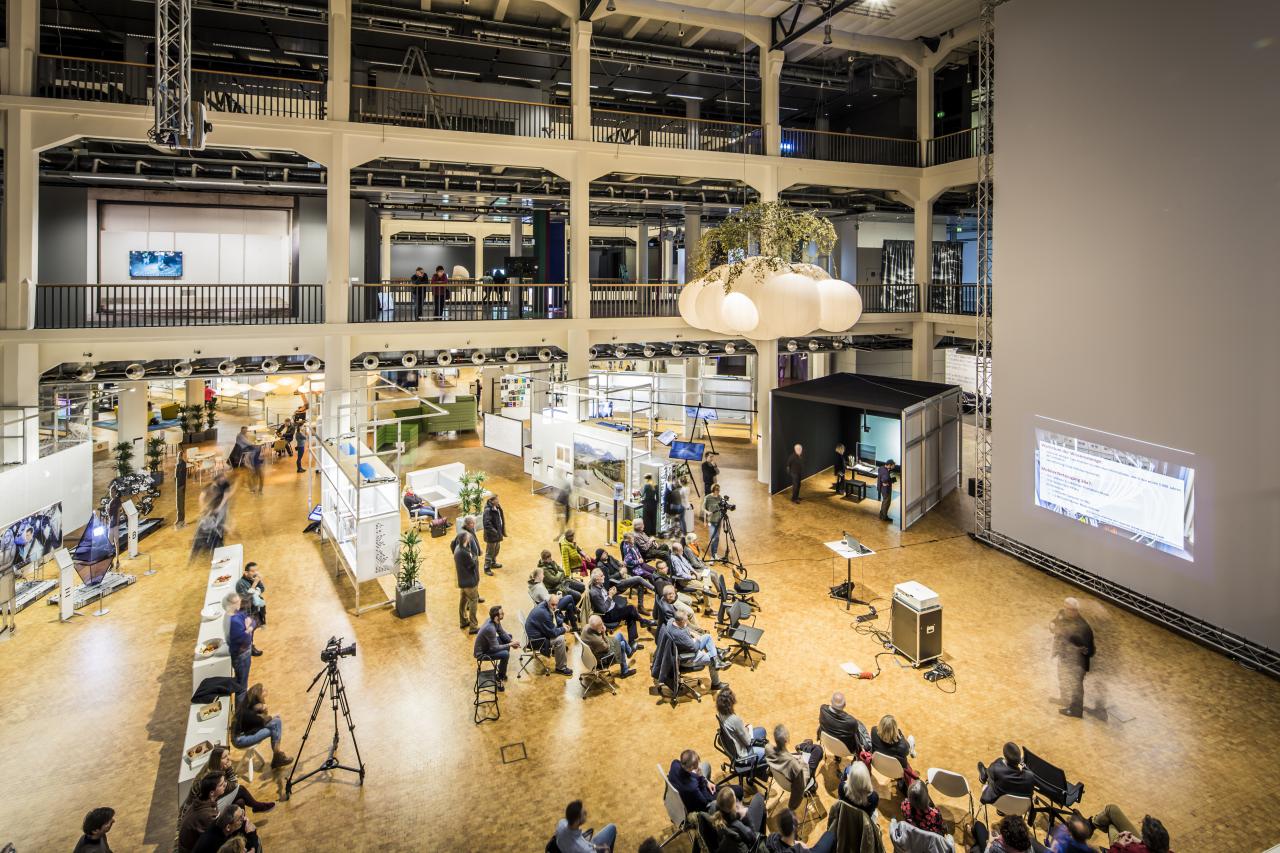
The Concept of the Exhibition: The Museum as Assembly
The discourse of the exhibition is laid out as an architectonic parcours to offer visitors the opportunity to use the Work Stations for independent creative activities. In addition to CoWorking Stations, visitors will also find rest and recreation areas where free fruit and drinks are available.
The architectonic concept and scenography of the Open Codes exhibition deviates substantially from the usual museum architecture of a white cube. Interspersed with the works on show are elements of studios, laboratories, offices, and a home environment. Here the museum serves as the commons, as an assembly: the museum becomes the venue of an open source community where people increase their competencies together, become more creative and knowledgeable. With this novel type of exhibition the ZKM presents a new option and a new function for the museum in the twenty-first century, which is necessary because of the changes that have taken place in political culture.
It is obvious that the previous forms of democracy and education are now so weakened that they no longer fulfill their mission and the expectations placed in them. All over Germany there are complaints that there is a state of emergency in the education system. And as for the current state of democracy, the titles of recent books speak volumes, literally: Post-Democracy (Colin Crouch, 2004), Defekte Demokratie [Defective democracy] (Wolfgang Merkel, Hans-Jürgen Puhle, Aurel Croissant et al., 2003), Simulative Demokratie [Simulative democracy] (Ingolfur Blühdorn, 2013). The evidence is overwhelming that representative democracy is in crisis. Since the European Union was founded, misguided policies have pushed Europe ideologically more and more to the right. It is imperative that new forms of democracy and education should be developed and tried out. Strangely enough, the museum is an ideal location for this. Why? Because the museum has been a heterotopia now for a long time, a location for exiles – at least as regards artistic forms of expression. The Sound Art of the twenty-first century is not heard or seen in the majestic buildings for opera and classical music, but rather (from time to time) in museums. Art films were forced to flee the cinema and television and go into exile in the museum. Likewise, new forms of dance, Action Art, and performance are mainly on view in art spaces. The utopian momentum of a society, in so far as it is reflected in art, now only remains latent in exhibition spaces. At given moments in history, this latency expands from artistic models into social models. It is now time to initiate new democratic, social and education policy movements, even if only at a micropolitical level. The museum could be an experimental space for innovative democratic possibilities, new forms of acquiring knowledge, and a new type of entrepreneurship which is based on new forms of cooperation. The basis for the conceptual slant of the exhibition, its selection of artworks, and its design operate on the premise that the key to an emancipatory exhibition lies in empowering the museum visitors and in their community. That is why we are giving the viewers the opportunity to experience the museum as a thinking space, as Co-Working Space, as Assembly, as a new form of congregating to exchange and acquire knowledge, and a new form of collaborating. Citizens educate other citizens. An unusual, interactive mode of engaging with art introduces them to this new strategy of an assembly. In part, the exhibition visitors themselves define a new format of exhibition as a preview of a future, self-confident and self-aware life that is non-hegemonistic.
The museum becomes a location for civic education, where acquisition of knowledge is not only worthwhile, but also rewarded. For the actual message of digital change is: the society of tomorrow will change (will have to change) into the knowledge society. Therefore, we demand free citizens’ education for the twenty-first century! We shall need culturally competent citizens in order to defend democracy in the future. And democracy needs thinkers. Therefore, the primary objective is to defend thinking within the museum. For is any thinking going on at all in the political arena or the mass media? Isn’t a trash president the ultimate triumph of trash TV? Sadly, we have gotten used to the voice of reason not being heard, because, as Sigmund Freud said, “The voice of the intellect is a soft one”[6]. But what is new is that the voice of reality is not heard either. When a phone rings in the government’s offices in Berlin and the reply to the secretary’s question »Who’s calling?« is »The voice of reality,« the politicians shout unisono »Don’t pick up the phone!« This is why Germany has become a dysfunctional democratic republic. Administration specialists talk increasingly of organization failure with fatal consequences for people. Schools lack teachers, hospitals and senior citizens’ homes lack nursing staff and caregivers. The helping professions, which are vital to existence and which we really need, earn next to nothing; the playing professions, from film actors to footballers, which we only need for entertainment and are therefore nowhere near as necessary, earn millions. The mills of the legal system grind slower than ever and achieve less frequently results; for example, the court case relating to the collapse of Cologne’s municipal archive only began after eight years. State authorities in Staufen in Baden-Württemberg were not even able to protect a nine-year-old boy from sexual abuse. It is not only due to staff cuts and semi-privatization of public facilities, but also because of the lacking willingness to respond appropriately to digital change that Germany’s infrastructure has imploded. The transport system (air, railway, and automobile traffic) is out of control and functionality is now the exception, no longer the rule. Above all because real-time data management is lacking. On the European Digitization Index Germany is ranked 17th, that is, it is a »developing country« in terms of digitization. Striving to retain power at all costs and ideological blindness have led to reality being sidestepped.
Thus, as a new form of assembly, the museum has the opportunity – together with the citizens – to develop as a site of knowledge and empowerment in order to regain access to reality using the instruments of thought.
Peter Weibel
[1] Immanuel Kant, The Critique of Practical Reason, trans. Thomas Kingsmill Abbott [1909], Part 2, Conclusion, London, Longmans, Green, & Co., reprinted 1954, 2004, available online at Projekt Gutenberg.
[2] G. W. Leibniz in a letter to Rudolph August, Duke of Brunswick-Lüneburg, known as the New Year’s Letter, January 12, 1697.
[3] English edition: The Order of Things [1966], Pantheon, New York, 1970.
[4] Ludwig Wittgenstein, Tractatus logico-philosophicus, 1921, Proposition 5.6.
[5] Galileo Galilei, II Saggiatore (1623), Edition Nazionale, vol. 6, Florence 1896, p. 232.
[6] Sigmund Freud, The Future of an Illusion [1927], The Standard Edition, trans. and ed. James Strachey, p. 53, available online at: https://archive.org/stream/sigmund-freud-the-future-of-an-illusion/sigmund-freud-the-future-of-an-illusion_djvu.txt.
